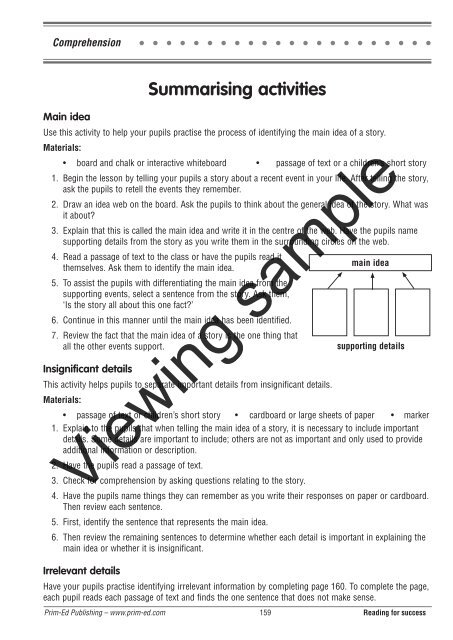PR-6218IRE Reading for Success - Book 3
Create successful ePaper yourself
Turn your PDF publications into a flip-book with our unique Google optimized e-Paper software.
Comprehension<br />
Main idea<br />
Summarising activities<br />
Use this activity to help your pupils practise the process of identifying the main idea of a story.<br />
Materials:<br />
• board and chalk or interactive whiteboard • passage of text or a children’s short story<br />
1. Begin the lesson by telling your pupils a story about a recent event in your life. After telling the story,<br />
ask the pupils to retell the events they remember.<br />
2. Draw an idea web on the board. Ask the pupils to think about the general idea of the story. What was<br />
it about?<br />
3. Explain that this is called the main idea and write it in the centre of the web. Have the pupils name<br />
supporting details from the story as you write them in the surrounding circles on the web.<br />
4. Read a passage of text to the class or have the pupils read it<br />
main idea<br />
themselves. Ask them to identify the main idea.<br />
5. To assist the pupils with differentiating the main idea from the<br />
supporting events, select a sentence from the story. Ask them,<br />
‘Is the story all about this one fact?’<br />
6. Continue in this manner until the main idea has been identified.<br />
7. Review the fact that the main idea of a story is the one thing that<br />
all the other events support.<br />
Insignificant details<br />
This activity helps pupils to separate important details from insignificant details.<br />
Materials:<br />
• passage of text or children’s short story • cardboard or large sheets of paper • marker<br />
1. Explain to the pupils that when telling the main idea of a story, it is necessary to include important<br />
details. Some details are important to include; others are not as important and only used to provide<br />
additional in<strong>for</strong>mation or description.<br />
2. Have the pupils read a passage of text.<br />
3. Check <strong>for</strong> comprehension by asking questions relating to the story.<br />
4. Have the pupils name things they can remember as you write their responses on paper or cardboard.<br />
Then review each sentence.<br />
5. First, identify the sentence that represents the main idea.<br />
supporting details<br />
Viewing sample<br />
6. Then review the remaining sentences to determine whether each detail is important in explaining the<br />
main idea or whether it is insignificant.<br />
Irrelevant details<br />
Have your pupils practise identifying irrelevant in<strong>for</strong>mation by completing page 160. To complete the page,<br />
each pupil reads each passage of text and finds the one sentence that does not make sense.<br />
Prim-Ed Publishing – www.prim-ed.com 159 <strong>Reading</strong> <strong>for</strong> success


















